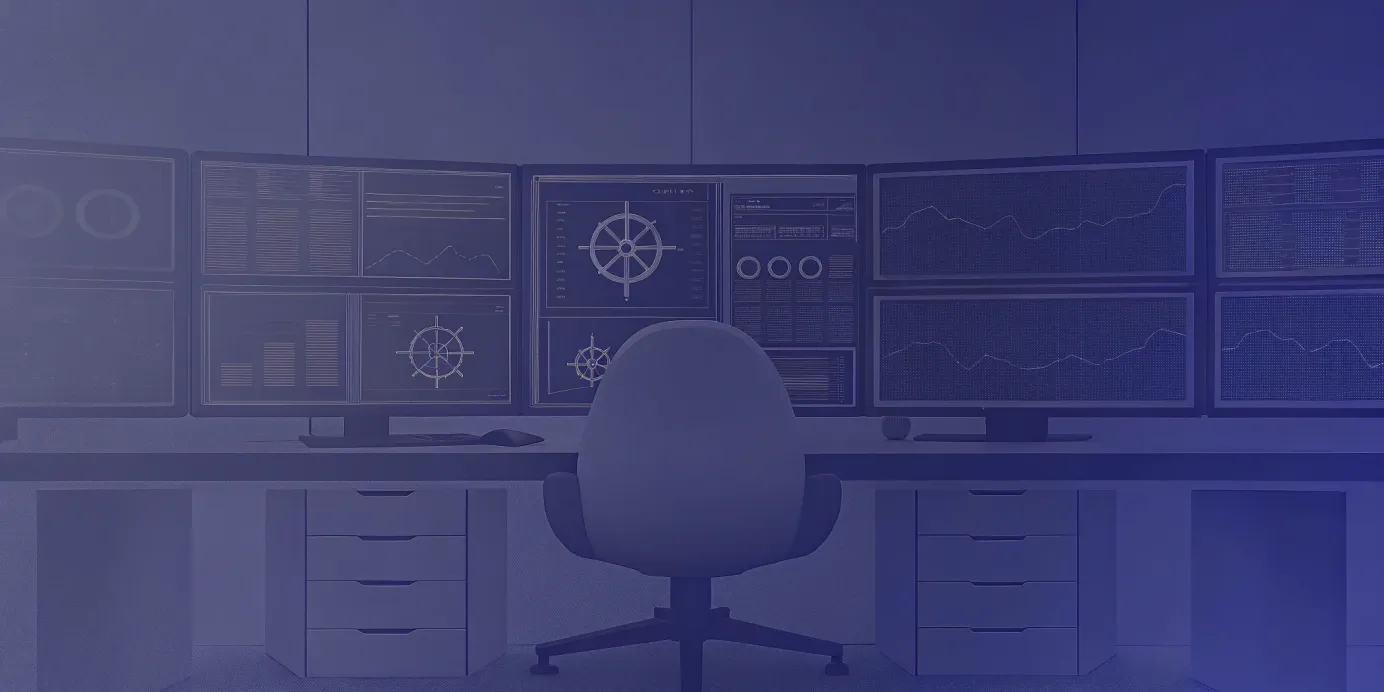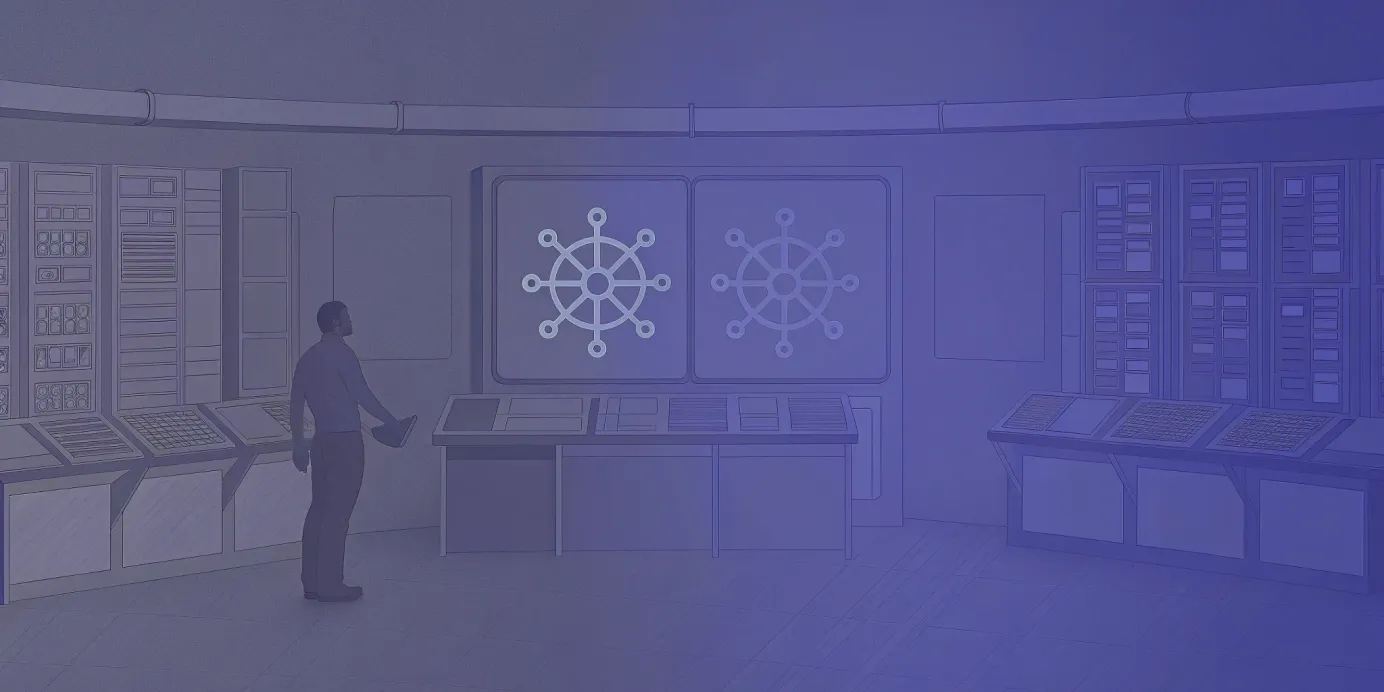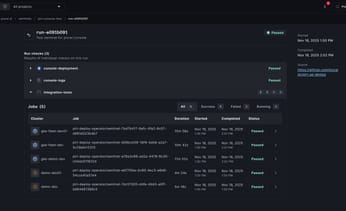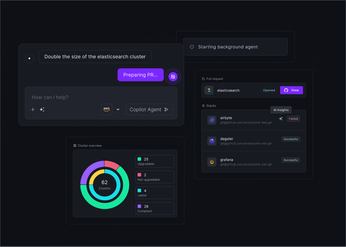
A Practical Guide to Kubernetes Compliance Automation
Get actionable steps for kubernetes compliance automation, including best practices, tools, and strategies to keep your clusters secure and audit-ready.
Policy as Code (PaC) applies the principles of software engineering to security and compliance. Instead of interpreting policies from static documents, you define them as version-controlled, machine-readable code. These policies can then be automatically tested and enforced across your Kubernetes environment.
With PaC, compliance checks become part of your CI/CD pipelines and admission control workflows, ensuring that every deployment is validated against your defined rules. This eliminates ambiguity, reduces manual overhead, and ensures consistent enforcement. By treating compliance as a software artifact, teams gain transparency, traceability, and a verifiable audit trail—forming a reliable foundation for Kubernetes compliance automation.
Unified Cloud Orchestration for Kubernetes
Manage Kubernetes at scale through a single, enterprise-ready platform.
Key takeaways:
- Define compliance as code: Translate your security and regulatory rules into version-controlled policies. By integrating these automated checks directly into your CI/CD pipeline, you enforce compliance continuously and catch issues before they reach production, moving beyond infrequent and error-prone manual audits.
- Combine tools for a layered defense: A single tool is not enough for comprehensive compliance. A robust strategy integrates policy engines like OPA Gatekeeper to block non-compliant resources, security scanners to find vulnerabilities, and GitOps principles to maintain a consistent, auditable configuration state.
- Automate for scale and audit readiness: Manual compliance checks fail at scale. Automation is essential for applying policies consistently across a large fleet of clusters, eliminating configuration drift, and generating the immutable audit trails required for audits. A platform like Plural centralizes this process, simplifying fleet-wide compliance management.
What Is Kubernetes Compliance Automation
Kubernetes compliance automation applies continuous enforcement to security and regulatory policies within a dynamic Kubernetes environment. Clusters change constantly (workloads, configurations, and network rules evolve in minutes) making manual audits both unreliable and unsustainable. A cluster validated one day might fall out of compliance the next.
Compliance automation solves this by embedding policy checks directly into your development and operational workflows. Instead of treating compliance as a periodic task, it becomes an ongoing process powered by automation. Policies are codified, version-controlled, and enforced through CI/CD pipelines and admission controllers. This enables real-time detection and remediation of issues, maintaining a consistent and auditable security posture across any number of clusters.
What Are Compliance Requirements
Kubernetes compliance spans the entire application lifecycle—from build to runtime. During development, this means securing the software supply chain through static code analysis, vulnerability scanning for container images and dependencies, and verifying artifact integrity via digital signatures.
At runtime, compliance shifts toward enforcing operational controls: full observability, detailed audit logs, and restrictive network policies that prevent unauthorized access. A strong compliance framework integrates both build-time and runtime measures to ensure end-to-end security coverage.
Key Regulatory Frameworks to Know
Several established frameworks provide actionable benchmarks for Kubernetes security and compliance:
- CIS Kubernetes Benchmark – Prescriptive best practices for securing Kubernetes configurations.
- NIST Application Container Security Guide – Guidance on mitigating risks inherent in containerized environments.
- NSA & CISA Kubernetes Hardening Guidance – Recommendations to reduce Kubernetes’ attack surface.
- MITRE ATT&CK® Matrix for Kubernetes – A tactical mapping of adversary behaviors in container ecosystems.
- PCI DSS – Standards governing data protection for organizations handling credit card transactions.
Familiarity with these frameworks helps teams align automation workflows with proven security baselines.
Why Automate Compliance
Manual compliance reviews are static and outdated the moment configurations change. They also consume significant operational time and introduce human error. Automation, by contrast, delivers continuous assurance. Integrating scanning and policy validation into your pipelines ensures that misconfigurations, vulnerabilities, and policy violations are caught before deployment.
Automated enforcement establishes a uniform security baseline across all environments, reduces audit complexity, and lets developers focus on shipping reliable applications instead of managing compliance checklists.
Common Challenges in Kubernetes Compliance
Despite clear frameworks, achieving continuous compliance remains challenging. Common issues include:
- Configuration Drift: Manual or ad-hoc changes can silently push clusters out of alignment with security baselines.
- Limited Visibility: Without centralized monitoring, it’s difficult to evaluate compliance across multiple clusters.
- Auditing Complexity: Kubernetes’ transient nature complicates activity tracing and evidence collection.
Plural simplifies these challenges by providing an embedded Kubernetes dashboard; a centralized interface that unifies visibility and compliance monitoring across your clusters, ensuring consistent control at scale.
Key Components for Automating Compliance
Kubernetes compliance automation isn’t achieved through a single tool—it’s built on an ecosystem of coordinated components. Each serves a specific role in enforcing, monitoring, and validating security standards. Together, they create a layered and resilient compliance framework that scales with your clusters. A policy engine might prevent a misconfigured workload from deploying, while a scanner detects emerging vulnerabilities in production. The goal is to integrate these systems so compliance becomes an ongoing, automated process embedded within your DevOps pipeline.
By building around these foundational components, you ensure that compliance isn’t a temporary audit state but a continuous, verifiable condition across your cluster lifecycle.
Policy Enforcement Engines
Policy enforcement engines form the backbone of proactive compliance. They implement Compliance-as-Code (CaC), converting organizational policies into executable, machine-readable definitions. Tools like OPA Gatekeeper act as admission controllers, validating Kubernetes API requests before resources are created.
You can use them to:
- Enforce resource limits on all pods.
- Block deployments that use the
latestimage tag. - Restrict workloads to trusted container registries.
This automatic enforcement ensures consistent security baselines across every cluster and eliminates manual intervention for common policy violations.
Security Scanning and Monitoring
While policy engines block known misconfigurations, scanners and monitoring tools handle runtime security. They continuously check container images, nodes, and clusters for vulnerabilities, misconfigurations, or malicious activity.
Security automation covers both static and dynamic scanning:
- Static analysis detects known CVEs in images before deployment.
- Dynamic monitoring tracks runtime anomalies and configuration drift.
Because new vulnerabilities emerge daily, continuous scanning ensures your compliance posture adapts in real time. Integrated monitoring tools provide the visibility necessary to identify and respond to threats immediately.
Configuration Management
Kubernetes’ flexibility often leads to configuration drift. Implementing GitOps-based configuration management solves this by making Git the single source of truth for cluster definitions.
Every change becomes a version-controlled, reviewable commit, ensuring traceability and reproducibility. Plural’s GitOps-powered deployment engine automates this process across all clusters, preventing unauthorized modifications and ensuring the live state matches the desired state. The result is a secure, auditable infrastructure aligned with compliance standards.
Access Control and RBAC
Access control determines who can interact with your clusters and at what privilege level. Kubernetes Role-Based Access Control (RBAC) enforces least privilege but can become unmanageable at scale. Automation ensures that RBAC policies are consistent across environments and simplifies compliance audits.
Plural integrates Kubernetes RBAC with your existing identity provider, enabling unified user and group management. This creates an SSO-driven access model where permissions are centrally defined, easily auditable, and aligned with compliance mandates.
Audit Logging and Reporting
Audit logging provides the evidence needed to prove compliance. Beyond simple event recording, it requires centralized, tamper-proof log collection and automated analysis to identify anomalies or violations.
Effective logging systems:
- Aggregate data from all clusters.
- Detect unusual activities or failed policy checks.
- Generate compliance-ready reports for audits or investigations.
Plural streamlines this by offering a unified dashboard that aggregates logs and compliance data from across your fleet. This central visibility simplifies reporting and helps teams maintain continuous audit readiness.
How Does Compliance Automation Work
Kubernetes compliance automation isn’t a single product or toggle; it’s a layered process that embeds security and compliance into every phase of your application and infrastructure lifecycle. Rather than relying on periodic manual audits, automation introduces continuous, code-driven guardrails that guide teams toward secure practices.
The process begins with defining compliance rules as code, then integrating them into development pipelines for early detection. Once in production, the same rules are used to continuously validate configurations, monitor for deviations, and automatically remediate violations. The result is a self-sustaining compliance system that minimizes manual effort, reduces human error, and provides real-time visibility into your security posture.
Implement Policy as Code
Policy as Code (PaC) forms the foundation of compliance automation. Instead of tracking requirements through static documents, you express them in declarative, version-controlled code. Policies are stored in Git, tested, reviewed, and applied consistently across environments.
Using tools like Open Policy Agent (OPA), you can create dynamic rules that adapt to context — for instance, enforcing encryption on all volumes or preventing containers from running as root. This shift toward Compliance-as-Code makes policy enforcement reproducible, auditable, and tightly integrated into your existing software delivery workflows.
Integrate with CI/CD Workflows
Compliance is most effective when embedded early in the delivery process. By integrating policy validation into CI/CD pipelines, developers receive instant feedback on potential violations before deployment.
A pipeline might automatically:
- Scan container images for vulnerabilities.
- Validate Kubernetes manifests against organizational policies.
- Block deployments that fail security or compliance gates.
Plural’s GitOps-based Continuous Deployment engine provides a framework for inserting these checks as required gates in your workflow, ensuring non-compliant code never reaches production. This “shift-left” approach reduces rework and keeps development velocity high without compromising security.
Automate Testing and Validation
Post-deployment compliance requires continuous verification. Configuration drift, dependency updates, or new CVEs can all create gaps in your security posture. Automated testing tools regularly scan running containers, validate network policies, and benchmark configurations against standards like CIS or NIST.
This continuous testing loop identifies risks early and eliminates the need for manual, reactive checks. Automation ensures that your clusters remain aligned with compliance baselines even as your environment evolves.
Set Up Continuous Monitoring
While automated validation detects deviations, continuous monitoring provides the real-time visibility needed to understand and respond to them. Logs, metrics, and events from across your Kubernetes fleet are collected and analyzed for suspicious activity or policy violations.
Typical monitoring workflows include:
- Detecting unauthorized API calls.
- Alerting on configuration changes to critical resources.
- Tracking repeated policy failures.
Plural simplifies this with a centralized dashboard that aggregates compliance data across clusters, helping teams investigate incidents and maintain continuous oversight without context-switching between tools.
Automate Remediation
The final stage of compliance automation is self-healing enforcement. When a violation is detected, automated workflows can trigger corrective actions:
- Add missing labels or annotations.
- Quarantine vulnerable workloads.
- Roll back to a last-known-good configuration.
These automated responses drastically reduce Mean Time to Resolution (MTTR) and close the gap between detection and enforcement. By combining policy enforcement, continuous monitoring, and automated remediation, you create a resilient, adaptive compliance system that scales seamlessly with your Kubernetes infrastructure.
Tools and Technologies for Automating Compliance
Kubernetes compliance automation relies on a coordinated ecosystem of tools rather than a single solution. Each technology plays a specific role—enforcing policies, scanning for vulnerabilities, managing configurations, or providing audit visibility. When integrated into your DevOps workflows, these tools transform compliance from a periodic manual task into a continuous, automated function. The right combination creates a secure, auditable foundation that scales with your infrastructure without slowing down development.
Policy Engines and Validators
Policy engines act as the enforcement layer for your compliance strategy. They operate as admission controllers, intercepting requests to the Kubernetes API and validating them against defined rules before any resource is deployed. This proactive approach ensures that non-compliant configurations never make it into your cluster.
With OPA Gatekeeper or Kyverno, you can define rules declaratively—such as requiring pods to specify resource limits, disallowing the latest image tag, or restricting deployments to approved registries. Because these rules are written as code, they can be version-controlled, tested, and reviewed like application logic. This brings predictability and repeatability to compliance enforcement and establishes a consistent security baseline across clusters.
Security Scanning Solutions
Policy enforcement stops bad configurations from entering your system, but security scanners continuously identify vulnerabilities in what’s already deployed. Automated scanning tools assess container images, runtime environments, and cluster configurations for CVEs, misconfigurations, and deviations from benchmarks like the CIS Kubernetes Benchmark.
These scanners provide continuous visibility by:
- Checking images for known vulnerabilities before deployment.
- Evaluating live clusters against compliance baselines.
- Monitoring for suspicious runtime behavior.
By generating actionable reports and alerts, scanning solutions close the loop between prevention and detection. They also simplify audit preparation by producing verifiable evidence that your organization actively manages risk.
Configuration Management Tools
Consistent configuration is a cornerstone of compliance. Kubernetes’ flexibility makes it easy for configuration drift to occur, which can lead to unintentional violations. Configuration management tools enforce consistency through IaC and GitOps workflows, ensuring every change is tracked, reviewed, and reversible.
Tools such as Helm, Kustomize, Argo CD, and Flux enable declarative management of cluster configurations—from deployment manifests to security policies like RBAC. Storing all configurations in Git creates a single source of truth and an auditable history of changes, allowing you to roll back to a compliant state when needed.
How Plural Automates Compliance
Plural unifies these practices into a single platform designed for managing Kubernetes compliance at scale. Its GitOps-based Continuous Deployment engine automatically synchronizes cluster configurations with version-controlled repositories, preventing drift and ensuring reproducibility.
With Global Services, you can define shared policies, such as RBAC rules, security agents, or monitoring configurations, and apply them consistently across multiple clusters. This eliminates repetitive setup and ensures every environment adheres to the same compliance baseline.
Plural also enhances access control with Kubernetes impersonation, mapping users and groups directly from your identity provider. This enables centralized RBAC management and seamless single sign-on, ensuring access policies stay aligned with organizational standards.
Documentation and Reporting Tools
Compliance requires both enforcement and proof. Documentation and reporting tools aggregate data from scanners, policy engines, and audit logs to generate evidence for standards such as SOC 2, HIPAA, or PCI DSS.
Automated reporting dashboards present real-time compliance metrics, highlight potential violations, and trigger alerts for remediation. By centralizing this information, teams can prepare for audits quickly and maintain ongoing visibility into their compliance posture. This automation turns audit preparation from a reactive scramble into a routine operational process.
Best Practices for Compliance Automation
Automating Kubernetes compliance requires more than just installing the right tools; it demands a strategic approach that integrates security and regulatory adherence into your daily operations. Effective compliance automation is built on a foundation of thoughtful architecture, efficient processes, and clear procedures. By adopting a set of best practices, you can create a system that not only meets current standards but is also resilient enough to adapt to future requirements. These practices ensure that your compliance efforts support, rather than hinder, your development velocity and operational stability. From planning your cluster architecture to establishing incident response protocols, each step is critical for building a robust and continuously compliant Kubernetes environment.
Plan Your Architecture
A well-planned architecture is the cornerstone of effective compliance automation. Designing your infrastructure with security and compliance in mind from day one simplifies the process of enforcing policies and maintaining standards later on. A key part of this is how you structure your deployment workflows. Integrating Kubernetes with CI/CD pipelines automates deployment processes, enabling more seamless and consistent application delivery without manual intervention. This architectural choice reduces the risk of human error and ensures that every deployment follows a predefined, compliant path. Plural’s agent-based, egress-only architecture is designed for this purpose, allowing you to manage clusters in secure, isolated environments while maintaining centralized control, which is critical for meeting stringent network security requirements.
Optimize for Performance
Compliance automation should not come at the cost of performance. Slow, inefficient security scans or policy checks can create bottlenecks in your CI/CD pipeline, frustrating developers and delaying releases. The goal is to build a system that is both secure and fast. By combining automation, scalability, and infrastructure as code, Kubernetes can form the backbone of a modern deployment pipeline that is resilient and efficient. Using tools that are designed for performance at scale is essential. For example, Plural’s Stacks feature manages Infrastructure as Code by executing runs on the target cluster, distributing the load and preventing performance issues on a central controller. This approach ensures your pipelines remain fast while handling complex infrastructure changes securely.
Manage Security Policies Effectively
Effective policy management is central to automating compliance. Instead of relying on manual reviews, you should define your security and compliance rules as code and enforce them automatically. This involves implementing strong network policies, leveraging admission controllers, and embracing automated security scanning to build a solid foundation for your Kubernetes security strategy. Tools like OPA/Gatekeeper allow you to enforce custom policies across all your clusters. Plural simplifies this process with its Global Services feature, which lets you define a single policy resource—like an RBAC configuration or a set of Gatekeeper constraints—and replicate it across your entire fleet. This ensures consistent policy application and dramatically reduces the administrative overhead of managing compliance at scale.
Monitor and Maintain Your Setup
Compliance is not a one-time setup; it's an ongoing process that requires continuous monitoring and maintenance. You need constant visibility into your environment to detect configuration drift, unauthorized changes, or emerging vulnerabilities that could put you out of compliance. Automated compliance and security scanning tools provide the continuous vigilance needed to ensure your environment remains secure over time. Plural provides a unified dashboard that acts as a single pane of glass for your entire Kubernetes fleet. This centralized view gives you real-time insight into the state of your clusters, helping you monitor configurations and access controls to ensure that your setup remains compliant without having to switch between multiple tools.
Establish Incident Response Procedures
Even with robust automation, incidents can happen. A clear, well-documented incident response plan is crucial for addressing security breaches or compliance failures quickly and effectively. Your plan should outline procedures for detection, containment, eradication, and recovery. Organizations must be proactive in securing their ecosystem with solutions that provide the visibility and detection capabilities that security and DevOps teams require. Plural’s integrated Kubernetes dashboard provides the deep visibility needed for effective incident response. By offering immediate access to logs, events, and resource statuses across all clusters, it helps teams quickly diagnose issues, understand their impact, and take the necessary steps to remediate them, minimizing downtime and risk.
How to Measure Your Compliance Success
Automating compliance is a significant step, but its effectiveness hinges on your ability to measure success. Without clear metrics, you're operating in the dark, unable to prove compliance, justify investments, or identify areas for improvement. A data-driven approach ensures your efforts are not only effective but also continuously refined. This involves defining what success looks like, tracking progress against those definitions, and creating a feedback loop to strengthen your compliance posture over time.
Define Key Performance Indicators
To measure success, you first need to define it. Key Performance Indicators (KPIs) are the specific, measurable metrics that reflect the health of your compliance program. Instead of vague goals, focus on quantifiable outcomes. For Kubernetes, this means moving beyond simple pass/fail checks. The goal is to "[automate] compliance assessments and enforcement at the infrastructure level," and your KPIs should reflect this automation.
Start by identifying metrics like:
- Mean Time to Detect (MTTD): How quickly does your system identify a non-compliant configuration?
- Mean Time to Remediate (MTTR): Once detected, how long does it take to fix the issue automatically?
- Compliance Score: What percentage of your resources (pods, nodes, services) are compliant at any given time?
- Policy Violation Rate: How many policy violations are detected per day or week?
These KPIs provide a clear, objective view of your compliance status and the efficiency of your automation.
Track Compliance Metrics and Reports
With KPIs established, the next step is to track them consistently. This requires tools that offer continuous monitoring and clear reporting. Manual checks are slow, error-prone, and don't scale. You need automated systems that provide "continuous vigilance, ensuring that your Kubernetes environment remains secure and compliant at all times." This is where a centralized dashboard becomes invaluable.
Plural's unified dashboard provides a single view across your entire Kubernetes fleet, making it easier to track compliance metrics in real time. By integrating with monitoring and security tools, you can visualize your KPIs, generate automated reports, and drill down into specific issues without juggling multiple tools. This centralized visibility is critical for identifying trends, spotting anomalies, and demonstrating compliance to stakeholders.
Ensure Audit Readiness
Audits are a fact of life in regulated industries. A successful compliance automation strategy transforms audits from a frantic, time-consuming scramble into a routine, low-stress event. The key is to be audit-ready at all times. By implementing Policy as Code, you create a self-documenting system where your compliance rules are version-controlled, testable, and auditable.
Your automation tools should generate detailed audit trails, logging every configuration change, policy enforcement action, and access request. When an auditor asks for evidence, you can simply pull a report showing that your policies have been consistently enforced. Plural’s GitOps-driven workflows ensure that every change is tracked in a Git repository, providing a clear, immutable record of who changed what, when, and why. This makes proving compliance straightforward and defensible.
Develop a Risk Assessment Strategy
Compliance is fundamentally about managing risk. A mature strategy goes beyond simply meeting a checklist; it involves identifying, assessing, and prioritizing risks specific to your environment. This requires a deep understanding of your architecture and data flows. To be compliant, you need to "keep records of actions (audit trails), and watch network traffic to stop unauthorized access."
Start by mapping your Kubernetes environment to identify critical assets and potential vulnerabilities. Use your compliance metrics to quantify risk—for example, a high number of unpatched vulnerabilities on internet-facing services represents a greater risk than a minor misconfiguration on an internal development cluster. Use this assessment to prioritize your remediation efforts, focusing on the issues that pose the greatest threat to your organization. This risk-based approach ensures you allocate resources effectively.
Create a Process for Continuous Improvement
Compliance is not a one-time project; it's an ongoing process that must adapt to new threats, regulations, and technologies. Your measurement strategy should feed into a cycle of continuous improvement. Use the insights from your KPIs, audit findings, and risk assessments to refine your policies, tune your automation, and strengthen your overall security posture.
This feedback loop is essential for maintaining a strong defense over the long term. For example, if you notice a recurring type of policy violation, it might indicate that a policy is unclear or that developers need better tools or training. By "[reducing] the manual effort required for audits and compliance reporting," automation frees up your team to focus on these higher-level strategic improvements, creating a more resilient and secure system.
Create a Future-Proof Compliance Strategy
Compliance in Kubernetes isn’t a one-time initiative—it’s an evolving discipline. Both the Kubernetes ecosystem and regulatory frameworks are in constant flux, so your compliance strategy must be built to adapt. A future-proof approach anticipates changes in standards, technology, and scale, embedding compliance into daily operations rather than treating it as a reactive effort. This means selecting flexible tools, automating repetitive processes, and promoting a culture of continuous improvement. Done right, compliance becomes a seamless part of your development lifecycle—sustainable, scalable, and minimally disruptive to developer velocity.
Keep Up with Emerging Standards
Regulations like PCI DSS, HIPAA, and SOC 2 evolve to address new risks and technologies. Your compliance system must evolve with them. Continuous monitoring and validation against benchmarks such as the CIS Kubernetes Standards help maintain alignment. Automation is key—tools that automatically refresh policy definitions based on updated frameworks enable your team to stay compliant with minimal manual effort. This proactive, automated posture prevents surprises when new mandates arrive.
Account for Technology Trends
Your compliance model should evolve alongside your infrastructure and delivery processes. As Kubernetes becomes central to CI/CD pipelines, compliance should shift left—integrated into each phase from commit to deployment. Embedding checks within the development pipeline ensures compliance is validated continuously, not retroactively. This adaptability prepares your systems for future technologies such as service meshes or serverless platforms without needing to redesign your compliance framework.
Plan for Scalability
Manual compliance cannot keep pace with growing environments. As clusters, services, and teams expand, automation ensures consistent enforcement across all deployments. Integrating compliance within CI/CD pipelines standardizes operations and eliminates bottlenecks. Platforms like Plural simplify this by using an agent-based model to apply and monitor compliance policies across thousands of clusters. This guarantees uniform enforcement and consistent security postures at scale.
Develop Strategies for Adaptation
Change is inevitable, so your compliance framework must be inherently flexible. Defining policies as code (PaC) provides that adaptability. Policies can be versioned, tested, and deployed like application code, making updates seamless when new requirements emerge. Combined with automated scanning, this ensures continuous compliance. Plural’s GitOps-driven model enhances this flexibility, synchronizing policy changes across environments automatically through version-controlled repositories.
Plan for Long-Term Maintenance
Even with automation, compliance systems need ongoing care. A future-ready strategy includes scheduled reviews, tool updates, and audit analysis to ensure continued effectiveness. Define clear ownership for policy maintenance, set review cadences, and track metrics to measure compliance drift. Automation dramatically reduces audit workload, but human oversight ensures accountability and refinement. Regular maintenance keeps your Kubernetes compliance system resilient and reliable over the long term.
Related Articles
- A Guide to SOC 2 Compliance for Kubernetes Workloads
- Kubernetes Adoption: Use Cases & Best Practices
- Managing Kubernetes Deployments: A Comprehensive Guide
Unified Cloud Orchestration for Kubernetes
Manage Kubernetes at scale through a single, enterprise-ready platform.
Frequently Asked Questions
What's the most practical first step to start automating Kubernetes compliance? A great starting point is to focus on visibility and implement a single, high-impact policy. Instead of trying to enforce dozens of rules at once, begin by deploying a policy engine like OPA Gatekeeper in audit mode. This allows you to see which resources would violate policies without actually blocking them. Then, introduce a simple, enforceable rule, such as requiring specific labels on all new deployments. This approach lets your team get comfortable with the Policy as Code workflow without disrupting development.
How can I enforce compliance policies without slowing down our CI/CD pipelines? The key is to integrate checks early and efficiently. This "shift-left" approach involves running lightweight validations, like checking Kubernetes manifests against policies, at the beginning of the CI process. This provides developers with immediate feedback. More time-consuming tasks, such as comprehensive container vulnerability scans, can be run in parallel or as asynchronous steps. A well-designed pipeline treats compliance checks as just another automated test, not a bottleneck that holds up a release.
What's the difference between a policy engine like OPA Gatekeeper and a security scanner? Think of them as serving two distinct but complementary functions. A policy engine like OPA Gatekeeper is a preventative control. It acts as an admission controller that intercepts API requests and blocks non-compliant resources from ever being created in your cluster. A security scanner, on the other hand, is a detective control. It inspects resources that are already running and container images in your registries to find existing vulnerabilities or misconfigurations. You need both to build a layered defense.
How does Plural help manage compliance consistently across a large fleet of clusters? Plural is designed specifically for managing Kubernetes at scale. Its Global Services feature allows you to define a single set of compliance resources, such as OPA Gatekeeper policies or standardized RBAC rules, and ensure they are applied uniformly across your entire fleet. This eliminates configuration drift and the manual effort of keeping hundreds of clusters in sync. Since Plural uses a GitOps-based continuous deployment engine, every policy change is version-controlled, providing a clear and auditable source of truth for your compliance posture.
My organization has to meet specific standards like PCI DSS or SOC 2. How does automation help with audit readiness? Automation shifts your organization from periodic audit preparation to a state of continuous readiness. By using GitOps, every configuration change is logged in a version control system, creating an immutable audit trail that answers who changed what, when, and why. Automated tools continuously generate evidence by logging policy enforcement actions and security scan results. When an audit happens, you can produce reports directly from your systems, proving that your controls are consistently enforced rather than manually assembling documents and screenshots.
Newsletter
Join the newsletter to receive the latest updates in your inbox.









